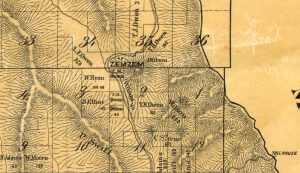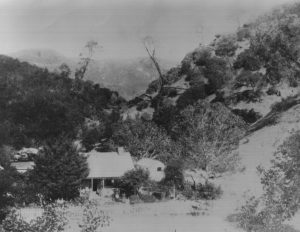Napa County, Tidings
“Zem Zem and the Lake County Mail” by Marie Bowen
This article was one of the three featured in our April 2017 Tidings. To get your copy of Tidings, become a member today!
Napa County Historical Society’s manuscript collection offers many first-person accounts of bygone events in our county and is a rich resource for researchers. One of these manuscripts is “Early Days at Zem Zem,” by Frank (Jay Franklin) Owen, a portion of Frank’s original 60-page memoir. Reading through the twelve-page manuscript I found the sentence, “The first long distance mail route through Napa County extended from San Francisco via Suisun to Lower Lake.” I had, in the past, researched the post offices in Napa County, including those located in the portion of Napa that became Lake County in 1862 (see Tidings Volume 22, No. 1). But Frank described how Lake, even after it became a separate county, received its non-local mail through Napa County. He provided no date for the commencement of this mail service, but at a Solano County website I learned the deliveries began, probably in late 1866.

Zem Zem, as seen on the 1876 Official Map of Napa County, lies about 15 miles north of Monticello, about seven miles south of Knoxville, and a mile or two west of the boundary line shared by Napa and Yolo Counties. Zem Zem’s spring, also referred to as Sulphur Springs, was perhaps the only source of aragonite, or onyx marble, in Napa County. According to Frank’s manuscript, “An enthusiastic visitor called the spring Zem Zem, that being the Arabic name for the Holy Well of Mecca.” Frank describes the settlement’s role in the Suisun-Lower Lake mail run as follows, with my comments in italics:
“The mail was conveyed weekly on a tiny side-wheel steamer (Ann Sophia) operated by Captain Jeremiah (Josiah) Wing. The mail was picked up at the Embarcadero at Suisun (Solano County) and carried in summer on a two-horse buckboard, in winter on horseback. The route was across the present site of Lake Curry, through Gordon Rancho and up Gordon Valley to the head of Cherry Valley – then called Rag (never Wragg!) Canyon because of the shreds of clothing left on the chaparral by the first explorers. The road continued on the west side of Putah Creek, to the Haines Ranch (probably Monticello resident George W. Haynes) crossing at a point about halfway from the “Big Rock” at the mouth of Capell Creek.
“Monticello consisted of a few dwellings and a hotel-store. This was the overnight stopping place for the mail the first day. The route continued along the general lines of the present highway through Berryessa Valley to the Adams Ranch (John Boon Adams) on Etiquerra [sic] Creek. From this point to its headwaters at Knoxville, the traveler crossed Etiquerra Creek 35 times in 10 miles. During occasional floods the carrier lay [sic] over either at Adams’ or at Sulphur Springs (aka Zem Zem) Hotel. The next day he went seven miles to the present site of Knoxville, where the road ended and a carrier from Lower Lake met him, taking over and exchanging mails. In winter the Suisun carrier returned to Sulphur Springs (Zem Zem) at night, in summer continued on to Monticello. In 1867 a road was built connecting Berryessa with Napa, and the Suisun-Lake mail was transferred to Napa City, the Lake County mail was then routed through Calistoga.”
Though I attempted to research further the 1867 Napa-Berryessa road mentioned above, the actual date of construction eluded my research efforts. In the spring of that year, Napa’s Daily Evening Reporter exhorted property owners to raise the remaining $6,000 needed to construct the road. The article reasoned that if Napa would not build the road, Solano County would, and it was possible that Berryessa Valley would then “split off” from Napa County and enjoy the benefits of shipping grain via Suisun. That, of course, did not happen, and by 1875 the Berryessa toll road was given public access status. When, precisely, the Suisun-Lake County mail run ended, I cannot say. It may have operated as briefly as did the western states’ portion of the Pony Express, fewer than two years.

There is more of interest in the manuscript, much derived from the pages of the diary that Frank’s father, Leander Owen, maintained during the family’s journey west. In 1849, Leander and his father Thomas – the “old school” Baptist minister who would establish the first Baptist church in Solano County – left Illinois with their families for Missouri, where they turned west. In a Conestoga wagon pulled by four yoke of oxen, they forded rivers alongside migrating bison herds, crossed the Great Salt Lake to “sink down, spent by hunger” into present-day Los Angeles, headed north to establish a Gold Rush era trading post on the Tuolumne River, lived in a tent near Rockville, Solano County, and eventually – “following the line of least resistance” – made their way into Coombsville, Napa County. The journey took about fifteen years; Frank was born in Suisun City in 1864.
Leander and Thomas settled near the Zem Zem mineral spring in 1865; Leander’s brother James arrived a few years later. As a young child, Frank lived at the Zem Zem/Sulphur Springs Hotel. Not only was it a mail stop; it served the Redington Mine Company’s freight teams, heading down from the mine above Knoxville with mercury crushed from cinnabar deposits. As Frank puts it, “Knoxville was born almost overnight.” Although Frank returned to Solano County by about 1900, later serving as the county’s agricultural commissioner, other Owen family members remained at Zem Zem. Frank died September 20, 1954, in Contra Costa County, at almost 91 years of age. His manuscript is a treasure, and can be read at the Napa County Historical Society’s Library.
Bibliography
Bowen, Jerry. “Newspapers offered mish-mash of news briefs.” Historical Articles of Solano County Online Database, June 12, 2005. Accessed March 10, 2017. http://www.solanoarticles.com/history/index.php/weblog/more/newspapers_offered_mish_mash_of_news_briefs/
Cooper, A. S. Catalogue of the State Museum of California. Vol. 5. Sacramento: California State Mining Bureau, 1899.
Gregg, Thomas. “Sketch of the Life of Elder Thomas H. Owen.” The Primitive Baptist Library of Carthage, Illinois, 2003. Accessed March 13, 2017. http://www.pblib.org/ThomasOwen.html.
Hunt, Marguerite. History of Solano County, California. Chicago: S. J. Clarke Publishing Company, 1926.
Lyman, Geo. G., S. R. Throckmorton, David L. Haas, and M. Schmidt & Co. Official Map of the County of Napa, California. Map. Napa and St. Helena Calif.: David L. Haas, 1876. Accessed March 13, 2017. Retrieved from the Library of Congress, https://www.loc.gov/item/2005625303/.
Noske, Carol. “Part 2 – Memories of Monticello and the Berryessa Valley.” Suisun Valley History Archives, November 5, 2007. Accessed March 10, 2017. http://www.bellavistaranch.net/suisun_history/berryessa2-noske.html.
Owen, Frank. Early Days at Zem Zem. Manuscript. From Napa County Historical Society.
Various articles. Daily Evening Reporter, February–May, 1867.
Various articles. Napa Valley Register, March 13, September 22, and September 24, 1954.


